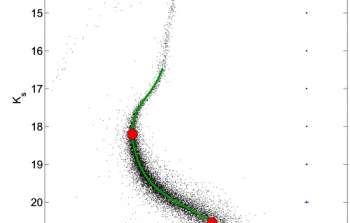sci15050 — Announcement
The Deepest Ground-based Photometry in a Crowded Field
October 13, 2015
This color-magnitude diagram of the crowded center of the globular cluster NGC 1851 combines near-infrared observations obtained using GeMS/GSAOI at Gemini South and optical data from the Hubble Space Telescope. Red dots mark the main sequence turnoff and the main sequence “knee,” around Ks = 18 and 20.5 magnitudes, respectively.
Paolo Turri (University of Victoria, Canada) and colleagues utilized the Gemini Multi-conjugate adaptive optics System (GeMS) with the Gemini South Adaptive Optics Imager (GSAOI) to obtain the most accurate and deepest near-infrared photometry from the ground of a crowded field, in the globular cluster NGC 1851. They also illustrate the remarkable potential of MCAO-equipped extremely large telescopes of the future. The delivered image quality approaches Gemini’s diffraction limit, with an average measured full-width at half-maximum (FHWM) of 0.09 arcsecond. The work is featured on the Gemini web page and published in The Astrophysical Journal Letters. A preprint is also available.
About the Announcement
| Id: |
ID
sci15050
|
